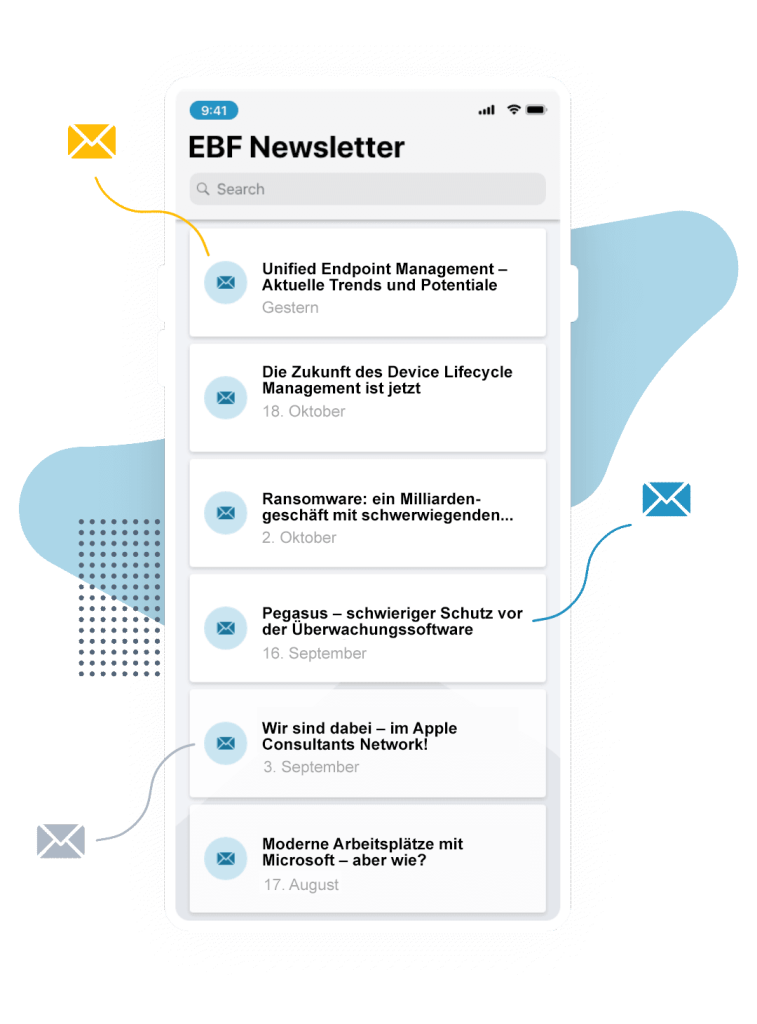Currently, many companies send their employees to the home office to protect them and their families and business partners from infection with the Corona virus (COVID-19) while maintaining operations. Companies that have not yet integrated this into their processes face great challenges. They must provide their employees with short-term access to relevant applications and data, but at the same time they need to worry about secure access to company data. Those companies where the home office is already a common working model are much better prepared for such a situation – especially when it comes to technology. But they are also facing challenges: For one thing, not all employees used to work in the home office, but only individual ones. On the other hand, it is likely that it is not just a matter of working from home for a few days, but probably over a longer period. For this, routines must first be developed.
We at EBF are also currently focusing on working in the home office and would like to share our experiences with you.
Challenges when working from the home office
The home office looks different for every employee. While some sit down at a desk and enjoy a quiet working atmosphere, others make room at the kitchen table, try to block out the sounds of household appliances or children and miss contact with their colleagues. So for some this creates space for creativity and undisturbed work, for others a challenge for concentration and motivation.
In addition, the technical conditions can also be very different: While some have a fast internet connection at home and own company laptops and mobile phones, which are managed by IT at best, others have to deal with slow internet loading times and use private devices for professional purposes, which are mostly unmanaged. So working at home can either be as effective as in the office, or it can be a test of patience or even a security risk.

This is how EBF organizes work in the home office
The technology is no problem
As an expert for the Digital Workplace, EBF is technically very well prepared for working in the home office. Many of our employees occasionally work from home also under normal circumstances or even have explicit home office contracts. For this, we make use of the technical products and solutions that we also offer our customers. So we not only help our customers to establish structures that make digital and mobile working possible, but we also design and live it ourselves. We are therefore able to access all data and applications in the home office, conduct appointments as online meetings, look after our customers’ systems and provide the usual support.

1. The right devices and the right software
Our colleagues are all equipped with mobile devices – iOS or Android smartphones and macOS or Windows laptops, as desired. Their hardware is comprehensively secured – for example, the hard drives are encrypted, and only defined hardware can be connected. In addition, the devices are securely managed by the internal IT department via a Unified Endpoint Management system and are equipped with appropriate configurations and security software as well as applications such as the entire Microsoft Office suite and Teams and a VPN client. The VPN client establishes a secure connection to all non-cloud services and enables access to our internal systems, such as our intranet platform for example. The configuration of the devices is set up in such a way that the employee can use the device securely even if he or she is in an insecure network – or in the home office, where IT also has no influence on the network.
UEM systems are already used by many companies – but currently often only for the management of iOS and Android devices. Companies may therefore now need to use the full range of functions of their deployed UEM solution to enable working in the home office. This is because Windows and macOS devices as well as private devices can also be managed with a UEM system without problems.
However, companies must also keep an eye on the capacities of the servers. For EBF, which has around 100 employees, it makes no difference whether 10 or 100 people work in the home office, as we treat all our devices as if they were outside the company network anyway to achieve maximum flexibility. The UEM system provides the necessary security. But if there are 5,000 instead of 100 employees in a company, the infrastructure can reach its limits. For this reason, it must be checked whether the lines or the servers are sufficiently scaled to allow a much higher number of employees to work in the home office with the internal servers.

2. Convenient and secure access
On the one hand, we want only authorized persons to access data and applications, but on the other hand, we also want the login to be as convenient as possible. For this reason, we have defined appropriate security standards in the UEM system, which regulate under which conditions a simpler or stricter authentication procedure – e.g. two-factor authentication – is applied during login or when no password is requested at all. In this way we can not only provide the necessary security, but also increase user-friendliness. After all, procedures that are too complex will frustrate employees and, in some cases, may lead them to circumvent the procedures or simply not use them anymore.
The technologies for simplification are available, they just have to be used consistently. At EBF, we connect almost all access points via “Certificate Based Authentication”. This involves storing a certificate on the EBF company device that is required for access to a system. This allows access to server data and functions without our employees having to log in again with a password each time. This ensures a frustration-free work of our employees, relieves the support and there is no time lost for a login. For EBF this method has proven to be very successful.
At EBF we have secured technical access to the (internal) services themselves with a VPN solution. Among other things, a solution from NetMotion is used here today. NetMotion’s software, which is distributed and configured via EBF’s UEM system, automatically establishes a VPN connection when accessing individual services, which secures communication between the end devices and the EBF’s backend systems. The use of the VPN solution is completely transparent for our employees.

3. Reliable infrastructure
EBF’s server systems are equipped in their connectivity and technical capacity to ensure that our colleagues can work with them without any problems, even if we are now in the home office. Of course, this does not happen overnight and required planning and testing. As a result, it puts us in a position where we don’t have to block services for colleagues just because there is not enough technical capacity.
In addition to its own servers, EBF also uses cloud services such as SAP or Microsoft services. Here, our capacity planning options are very limited, but the solution providers have always had sufficient performance reserves to guarantee high-performance and ensured reliable work conditions.
Services such as Microsoft Teams are currently being used more and more at EBF for chats, telephone calls and video conferences as the usual communication in the office is no longer possible. This helps us to overcome the current challenges in communicating with each other. Of course, there are also a lot of tools on the market that can offer such functions (e.g. Slack). It is simply important for us to provide our colleagues with such communication tools so that they can effectively and reliably communicate with each other and maintain continuous coordination. And of course, the company mobile phone remains a central instrument for communication.
Since one or the other employee has to or wants to print out something in the home office, every employee can access the printers in the home network. These are regulations that the EBF has put into effect to guarantee the smoothest possible work conditions. Of course, this is not possible without rules, which, for example, specify how to deal with printouts. But there is a solution for (almost) everything.
The processes require a plan B
So technically, we at EBF are very well positioned and have long since geared almost all processes to working in the home office. Nevertheless, there are processes that cannot be copied 1:1 in the home office: The mail still lands in the office, signatures from management cannot be obtained easily and trial days for new employees cannot be carried out.
In order to solve some of these problems, we have introduced a shift system that regulates that a maximum of one person per team may be on site. In this way we significantly minimize the physical contact possibilities and also implement the hygiene measures recommended by the Robert Koch Institute.
Today, the mentioned signatures can be processed electronically and yet securely. We are about to introduce DocuSign for this and will use it for our signature processes. This enables us to obtain the necessary signatures on contracts etc. even when no one is in the office, and also to have external partners sign electronically. The processes and the tool serve us very well – not only in the home office.
The daily organization is a challenge
Many employees are used to working from home for a few days. But if you have to work in your home office for a longer period of time, this is a significant change even for experienced home office workers and requires a few tips and tricks to ensure that working from home remains enjoyable and effective in the long run.
1. Daily routines
We advise our employees to establish a routine – with a regular start of work, breaks and a fixed end of work – and to get ready in the morning as if going to the office. A little exercise in between and fresh air are also advisable.
2. Pleasant workplace
We recommend our employees to set up a “real” workplace that is as free as possible from noise and offers enough space to work. As there are currently often several people per household working at home, it is necessary to coordinate with each other – especially if children must be looked after at the same time.
3. Regular communication
We have requested our colleagues to convert internal and external appointments into online meetings. But this does not always have to be about professional exchange. Employees should also replace the conversation that usually takes place in the office or at the coffee machine with online meetings or a short chat. Turning on the camera can help to create a little more office atmosphere. Of course, this should not end in distraction. Managers are particularly challenged in this respect. They should actively promote exchange with their teams and coordinate their work well.
4. Sensitized employees
It is to be feared that criminals will exploit the Corona virus and try to persuade users to open harmful attachments with supposed tips on how to deal with the Corona virus. We have sensitized our employees to this and called for special caution when opening links and attachments.
5. Home office policies and support
Our advice is to summarize and communicate all information concerning working in the home office. It is important to point out to the employees that there may be more complicated processes, so that they do not discover these frustratedly on their own way. Employees should also have the opportunity to address questions and problems to a support team.
We are very well positioned to cope with the current situation and to both protect our employees and maintain our performance. And of course, we wish you the same. Feel free to contact us if we can support you with your challenges and help you to implement home office work.







